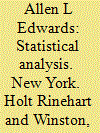|
|
|
Sort Order |
|
|
|
Items / Page
|
|
|
|
|
|
|
| Srl | Item |
| 1 |
ID:
136231


|
|
|
|
|
| Summary/Abstract |
The building sector of China currently consumes 20% of the total energy consumption. Studies on barriers to the adoption of building energy-saving technologies are of great significance on implementing policies related to achieving energy-saving goals. This paper studied 15 barriers with the aid of information collected through questionnaires and semi-structured interviews. The respondents were 135 employees working in the Jing-jin-tang area. Based on the results of the factor analysis, the barriers were categorized into five groups: attitudes of stakeholders, policies and regulations, auxiliary resources, profitability, and adaptability of the technologies. Analysis of the entire sample showed that the stakeholders’ reluctance to use was the largest barrier, followed by high initial investment and low profitability. Further analysis showed that the occupation and designation of the respondents and the size of the enterprises that they served influenced their perspectives on the barriers. It was found that architects attributed more importance to the adoption of energy-saving technologies than contractors; barriers confronted by employees of large enterprises and small enterprises were different; managers perceived weaker barriers than frontline employees and were more optimistic about the prospect of building energy-saving technologies. Finally, policy recommendations were proposed based on these in-depth and targeted analyses.
|
|
|
|
|
|
|
|
|
|
|
|
|
|
|
|
| 2 |
ID:
144895


|
|
|
|
|
| Summary/Abstract |
This study article focuses on American far-right (FR) extremists who committed ideologically motivated violent or financial crimes in the United States. We examine three research questions. First, are certain types of FR ideological beliefs associated with different types of criminal behavior? Second, can the various indicators of FR ideology be used to create a scalar measure of commitment to FR ideology? Third, which typology of the FR movement provides the most reliable measure of FR extremism? We use data from the United States Extremist Crime Database to measure indicators of FR ideology in a sample of 305 FRs who committed a financial crime or homicide between 2006 and 2010 in the United States. Conspiratorial, antigovernment, and antitax beliefs were positively associated with risk of financial crimes, while xenophobic, survivalist, and anti–gun control beliefs were positively associated with risk of violent crimes. A factor analysis created a commitment to FR ideology scale and identified four sub-types of FRs: Conspiracy Theorist, Survivalist, Movement Participant, and Proud far-rightist. The factor analysis did not support the prevailing typologies. Importantly though, these typologies were useful in predicting criminal behavior patterns of far rightists. We outline a number of other measurement issues for future research to address.
|
|
|
|
|
|
|
|
|
|
|
|
|
|
|
|
| 3 |
ID:
125457


|
|
|
|
|
| Publication |
2013.
|
| Summary/Abstract |
This paper develops an indicator for the energy development potential (EDP) of 27 Brazilian states. This indicator uses data on a state's infrastructure and its supply of and demand for energy. The indicator measures the data for three periods: the first part of the 1990s, which is a period of low economic growth; the first part of the 2000s, which is a period of high economic growth but with a historical crisis in the Brazilian energy sector; and 2009-2011, which is a period of economic growth after the energy crisis. Using a factor analysis, we are able to identify three factors for EDP. They are the demand for energy, the supply of renewable energy, and the supply of nonrenewable energy. We use these factors to classify the Brazilian states according to their EDP and to perform an exploratory spatial data analysis (ESDA) by using the Moran indicators and the local indicators of spatial association (LISA).
|
|
|
|
|
|
|
|
|
|
|
|
|
|
|
|
| 4 |
ID:
168303


|
|
|
|
|
| Summary/Abstract |
As electricity consumption in Vietnam has continued to increase much faster than has GDP, electricity intensity (EI) in the country has risen to levels far exceeding those of other Asia-Pacific economies (APEs). By analyzing evidence from a comparative study of other APEs through using the World Bank data, this study proves that EI in Vietnam is excessive and that its escalation over the last few decades cannot be justified as being due to supporting the country's policy of high economic growth. Factor analysis of the economic and electricity indicators for 22 APEs was used to track the shortcomings of the economic structure leading to the EI escalation in Vietnam. Electricity tariff, service share of GDP, and level of institution were identified as determinants of EI across the region. Given the weak performance regarding these indicators, Vietnam has highest EI among APEs followed by China and Mongolia. To reduce EI, Vietnam should consider diversifying away from the electricity-intensive industry sector toward economic activities such as service and information technology. The economic reform should be accelerated to complete the competitive electricity market and reduce the inefficiency of electricity usage through poorly managed state-owned enterprises and inefficient public investment projects.
|
|
|
|
|
|
|
|
|
|
|
|
|
|
|
|
| 5 |
ID:
042339


|
|
|
|
|
| Publication |
New York, Holt, Rinehart and Winston, 1965.
|
| Description |
xix, 730p.Hardbound
|
|
|
|
|
|
|
|
|
|
|
|
Copies: C:1/I:0,R:0,Q:0
Circulation
| Accession# | Call# | Current Location | Status | Policy | Location |
| 002295 | 519.5354/HOR 002295 | Main | On Shelf | General | |
|
|
|
|
| 6 |
ID:
181759


|
|
|
|
|
| Summary/Abstract |
India's energy demand is expected to rise to 4000 TWh by 2030. The country will require five times more renewable energy (RE) in 2030 to meet the policy targets. The current RE development plans are land-intensive, highly intermittent, low-capacity utilization, and the inability to support the baseload requirement. It is time for India to diversify its RE basket and accommodate ocean energy (OE) in its policy landscape. Studies have identified factors for RE sources such as solar, onshore wind, and offshore wind etc. Literature clarifies that policy plays a vital role in developing RE. Hence, this study aims to identify the factors for OE development. The responses were collected from the stakeholders interested in RE development in India. This study has ranked grid connection and capacity building as the top two variables using the weighted average method. Factor Analysis results identified six factors: government support, regulatory and fiscal incentives, financing mechanisms, economic tools, promotion of local content, and capacity-building for research and skill development. Promotion of local content and capacity-building are additions to the literature as factors. This paper advocates the socialisation of evacuation cost, financial, fiscal certainty and continuity, priority sector lending, and demand-supply side support for OE development.
|
|
|
|
|
|
|
|
|
|
|
|
|
|
|
|
| 7 |
ID:
155767


|
|
|
|
|
| Summary/Abstract |
This paper studies what kinds of meanings reserve officers ascribe to military ranks. The study builds on existing literature on reserve forces and hypothesizes that military ranks among reserve officers are subject to rendering the ranks with multiple meanings, and which are bound to create ambiguity of interpretation. To elaborate these theoretical insights a survey among Finnish reserve officers was conducted (N = 6193). The data was analyzed using factor analysis and correlation analysis. The results show that military ranks are ascribed, in addition to the functionalistic, hierarchical meaning, also with meanings of prestige, proficiency, and identity. The main theoretical contribution of the paper is in complementing the previous literature on ambiguity of military ranks by specifying four different meanings in the interpretation of the ranks.
|
|
|
|
|
|
|
|
|
|
|
|
|
|
|
|
| 8 |
ID:
156137


|
|
|
|
|
| Summary/Abstract |
This paper examines issues of techniques and factor analysis in research in general and in military history research in particular, which determine the functioning conditions for the phenomenon or process under examination.
|
|
|
|
|
|
|
|
|
|
|
|
|
|
|
|
| 9 |
ID:
102716


|
|
|
|
|
| Publication |
2011.
|
| Summary/Abstract |
We empirically investigate the factors that drive the uneven regional distribution of foreign direct investment (FDI) across Chinese provinces from 1995 to 2006. We first perform a factor analysis to summarize information embodied in around 40 variables and derive four FDI determinants: 'institutional quality', 'labour costs', 'market size', and 'geography'. Applying these estimated factors, we then employ instrumental variable (IV) estimation to account for endogeneity. In line with theoretical predictions, we find that foreign firms invest in provinces with good institutions, low labour costs, and large market size. The Arellano-Bond dynamic panel generalised method of moments (GMM) results show strong agglomeration effects that multinationals tend to invest in provinces which attract other foreign firms, consistent with the economic geography literature. Several robustness tests indicate that low labour costs combined with improvements in institutions are the key for attracting FDI in China.
|
|
|
|
|
|
|
|
|
|
|
|
|
|
|
|
| 10 |
ID:
042305


|
|
|
|
|
| Publication |
New York, Holt rinehart and Winston, 1965.
|
| Description |
xii, 234p.
|
|
|
|
|
|
|
|
|
|
|
|
Copies: C:1/I:0,R:0,Q:0
Circulation
| Accession# | Call# | Current Location | Status | Policy | Location |
| 002289 | 519.5354/EDW 002289 | Main | On Shelf | General | |
|
|
|
|
|
|
|
|
|